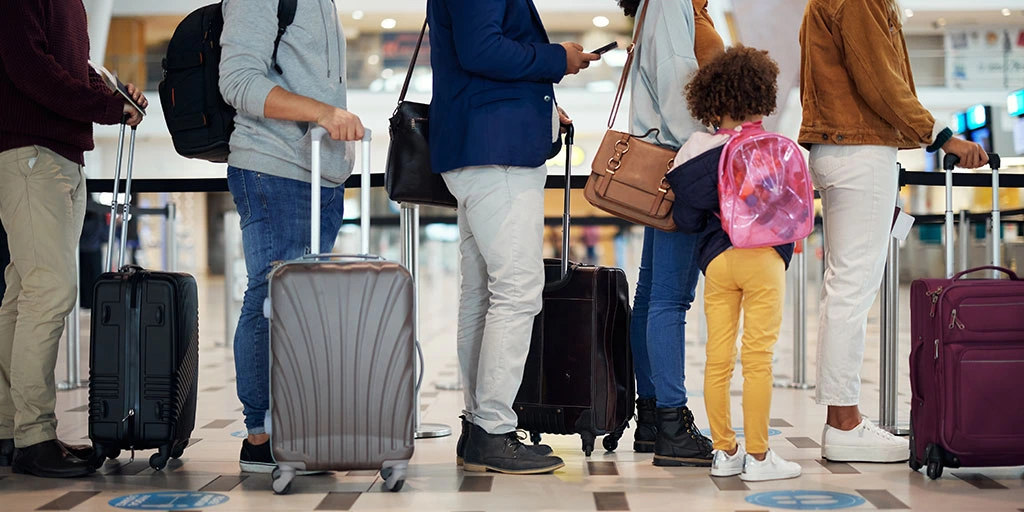Flying with an Autistic Child: The Ultimate Guide
Updated on September 14, 2025Airports can be overwhelming for anyone, but for families with an autistic child, the experience can be especially challenging. Loud noises, agitated crowds, long lines, and unexpected schedule changes are just a few of the stressors that can make the journey almost too challenging to take.
Yet with the right preparation, airport travel with an autistic child doesn’t have to be something you dread; it can become a smoother, more manageable, and even empowering experience for both you and your child. This step-by-step guide walks you through all the practical tips—from preparing at home to getting through security and boarding to preventing a meltdown—so you can focus less on the chaos and more on creating a positive travel experience together. Let’s not delay your departure for discovering the top autism air travel tips below:

Preparing for the Journey
No trip is flawless, because so many factors are out of our control. Focus on the things that you can control: i.e. which flight to book, communications with the airline ahead of time, preparing your child with the help of visual tools, packing the right comfort items, and even simulating a practice run-through. You won’t be able to eliminate every potential bump along the way, but by being prepared, you can make flying with an autistic child much smoother.
Smart Booking
Depending on the time of year and your destination, booking a direct flight may cost more, but it avoids having to repeat the entire deplaning/boarding/waiting process. Try to select a flight that departs during non-peak hours. Ensure that a familiar adult is seated next to your autistic child for reassurance and support, and ask if they would prefer to sit by the window or aisle. If your kid is a picky eater, make sure to pack favorite foods instead of relying on what the airline gives you.
Getting to the Gate
Try to get dropped off as close to the gate as possible–and opt for curbside checking if it’s an option. It might be worth investing in a taxi to avoid the trek from the parking garage. You want to get there early, but not too early. Minimize luggage by packing as concisely as possible (that applies for carry-ons, too). Check that all passports are valid—many countries require at least six months of validity beyond your travel dates. Be sure to keep all of your important documents in a safe, accessible place.
At Your Destination
The challenges don’t end once you land. Book ahead of time your uber, rental car, hotel, or any other accommodations you or your child may need. Keep in mind your return trip, as well – and repeat any necessary bookings or special requests that will make the return go equally as smoothly. If you’re not familiar with your destination airport, take a minute to approach the information desk upon your arrival and clarify any questions that may help you for the day of your return flight.

Creating a Visual Schedule or Social Story
Introduce your child to this new experience of air travel the same way you would any new activity. It takes people with autism longer to adjust to changes in routine and the familiar; but by using explanatory tools in advance, this predictability reduces anxiety and makes transitions easier. Pick a visual that illustrates the process of air travel: arrival, security check, waiting around, shopping, boarding, and even the dreaded departure delay. As you show these to your child, explain verbally as well: “Here is where we drop off our suitcase”, “Here is where we go through security”, “Here is where we board the plane”, etc. These visuals can be:
- Autism travel visual schedules, presented on a board, that display the name of the activity along with an illustrative image
- Picture cards with similar details, but which you can go over with the autistic child as a sort of quiz
- Printable social stories for air travel that combine text and pictures that tell the tale of getting on an airplane
Sensory Tools for the Airport and Flight
When in unfamiliar territory, autistic people like to turn to the things that give them comfort. There are many recommendations for sensory-friendly travel for kids, but it often boils down to individual preferences. These include noise-canceling headphones, fidget toys, weighted items, sunglasses, and snacks. Make sure you put a reminder to pack these comfort items, and keep them handy in a carry-on. You may even consider packing an extra as backup, in case something gets lost in-transit.
Deep pressure techniques can also be a powerful way to calm someone with autism. In addition to weighted blankets, you can try compression garments, joint compressions, and deep pressure massage, which provide firm, grounding input. You can also try engaging your child in focused tasks, which may help distract them from whatever is triggering them.
Autism Meltdown Prevention During Travel
Despite your best efforts, your child may still have a meltdown. It’s not uncommon while traveling, even for children who don’t have autism – flight delays, gate changes, crowds, bright lights, and long lines can make anyone feel frustrated and overwhelmed.
Travel preparation for special needs includes keeping a close eye out for your child’s particular warning signs. These might be in the form of pacing, repetitive questioning, stimming, or refusing to move. Then, use the de-escalation techniques that have worked in the past. Finding a quiet area is often useful, so try to note relatively deserted locations, such as gates that won’t open for a while. Some airports even provide recommendations about these areas.
But most importantly, stay calm! (We know, easier said than done.) Remind yourself that you’re not the first family to endure an airport meltdown. Focus on the calming strategies that work best for your child—one step at a time. You can always ask airport employees for assistance. And breathe.
Navigating Security Checkpoints
The security check can be confusing for children with autism, as they often don’t understand what the fuss is all about. Before you get there, be sure to inform the airline employee at check-in about your child’s special needs, so that you can request special accommodations such as avoiding separation at security (they may even let you cut the line). You can also simplify the security experience by having all the necessary documents ready and in hand. But there’s no guarantee that no waiting will be required – not to mention needing to keep an eye on your child while answering TSA questions.

Fortunately, many airports, airlines, and security organizations offer services specifically for families with autistic kids:
- TSA Cares for autism is a program that accommodates travelers with medical issues and children.
- Major airports have programs in place to notify staff when a person has disabilities, such as the Hidden Disabilities Sunflower Lanyard at JFK airport.
- Some airlines set up special “practice flight” events for autistic children, where they can go through the air travel process, including security. You’d also be surprised how many of them publish social stories about air travel and autistic child airplane guides.
Boarding & In-Flight Tips
After security, you may have a lot of time to kill, so find an area where your child can relax a bit and engage in a comforting activity. You probably want to steer clear of the shopping concourse, with all of its bright lights, crowding, and strong stench of perfumes.
Get to your gate early so that you have plenty of time to approach the desk and let them know that you’ve requested pre-boarding. Double-check that your seating request has been confirmed (whether that’s a window seat for less stimulation, or an aisle seat for easier access and freedom of movement).
When you’re on the plane, keep important carry-ons easily accessible, whether that’s sensory or comfort items, snacks, headphones, and the like. Show your child how to use the entertainment system (which may require downloading) and have a phone/tablet charger, as well as batteries, as a backup just in case.
Staying Safe at the Airport
Airports are crowded, noisy, and full of temptations. In other words, they are fertile ground for wandering. That’s why having a location monitoring solution specifically designed for people with autism is vital.
AngelSense is an assistive technology designed to ensure maximum safety, provide effective remote support, and foster independence for children and adults with special needs. It includes:
- AI-powered continuous monitoring and alerting system with indoor capability
- An app for multiple caregivers featuring proactive alerts and live tracking map
- Wearable device with SOS button and auto-pickup speakerphone for 1- and 2-way calls
- First responder support such as live location sharing, runner mode, alarms, and location playback
- Customer support by parents of children and adults with special needs
When it comes to traveling with an autistic individual, AngelSense can make the difference between a bit of panic and a ruined trip.
Real-Life Stories & Parent Testimonials
Flying can feel like a real adventure, particularly for young kids. The special excitement and stimulation of going on an airplane is even more heightened for those with autism. To illustrate, here are some real-life airplane travel stories that are both heartwarming and inspiring:
- Landon Bjornson, a 7-year-old boy with autism, was alone on a four-hour flight. His mother gave him a note stating that he might be asking a lot of repetitive questions. Instead of finding Landon to be annoying, his fellow passenger sent a message to his mother about how Landon is a “great travel buddy.”
- When Brayson, a 4-year-old boy with autism, had a meltdown on a flight, his parents tried everything they knew to get him to calm down. That’s when fellow passengers and crew jumped in to help, offering distractions and comfort to keep him quiet. A crew member even gave the mother a note of commendation.
- The parents of autistic boys Haydn and Ethan (no relationship) were both reluctant to travel with them for fear of meltdowns and getting lost. However, the Autism In The Air program at Belfast Airport helped everyone successfully overcome their fear of flying.
Empowered Travel Is Possible
While air travel with an autistic child may seem daunting, thoughtful preparation and the right support will make your trip safe, smooth, and (yes!) even enjoyable. It’s one more stepping stone in the journey towards greater independence – for both your child and you. Take on the challenge with confidence and compassion, knowing that you are armed with all the necessary precautions, and that with each trip, your child will get increasingly more comfortable with traveling. After all, travel is the ultimate symbol of freedom.
Get peace of mind from AngelSense, the groundbreaking AI-based assistive technology designed to enhance safety and peace of mind for individuals with special needs and their families. Our solution ensures you stay connected with your loved ones, empowering a higher level of independence while maintaining safety. Learn more about how AngelSense can make a difference for your family.

